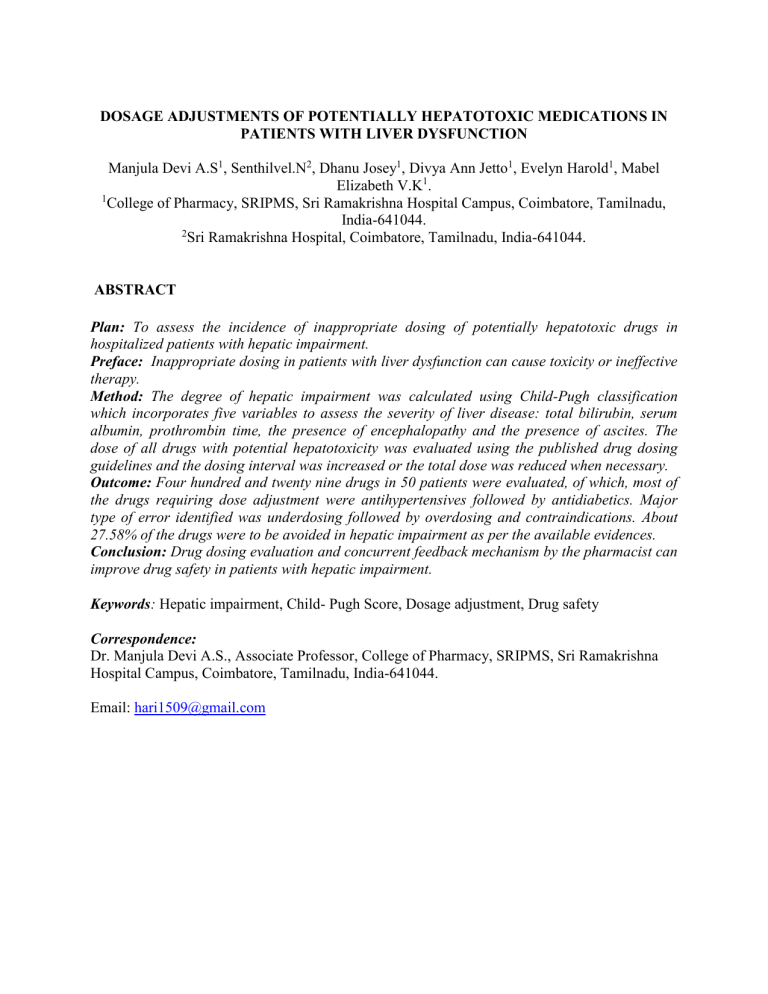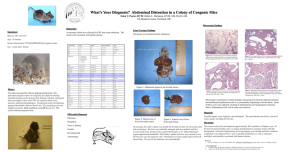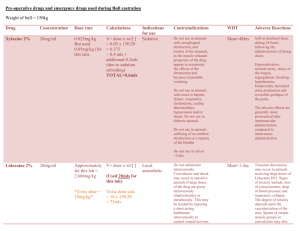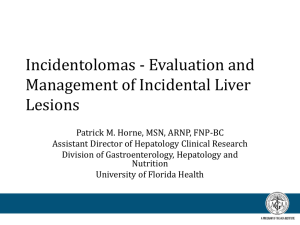DOSAGE ADJUSTMENTS OF POTENTIALLY HEPATOTOXIC

DOSAGE ADJUSTMENTS OF POTENTIALLY HEPATOTOXIC MEDICATIONS IN
PATIENTS WITH LIVER DYSFUNCTION
Manjula Devi A.S
1
, Senthilvel.N
2
, Dhanu Josey
1
, Divya Ann Jetto
1
, Evelyn Harold
1
, Mabel
Elizabeth V.K
1 .
1
College of Pharmacy, SRIPMS, Sri Ramakrishna Hospital Campus, Coimbatore, Tamilnadu,
India-641044.
2
Sri Ramakrishna Hospital, Coimbatore, Tamilnadu, India-641044.
ABSTRACT
Plan: To assess the incidence of inappropriate dosing of potentially hepatotoxic drugs in hospitalized patients with hepatic impairment.
Preface: Inappropriate dosing in patients with liver dysfunction can cause toxicity or ineffective therapy.
Method: The degree of hepatic impairment was calculated using Child-Pugh classification which incorporates five variables to assess the severity of liver disease: total bilirubin, serum albumin, prothrombin time, the presence of encephalopathy and the presence of ascites. The dose of all drugs with potential hepatotoxicity was evaluated using the published drug dosing guidelines and the dosing interval was increased or the total dose was reduced when necessary.
Outcome: Four hundred and twenty nine drugs in 50 patients were evaluated, of which, most of the drugs requiring dose adjustment were antihypertensives followed by antidiabetics. Major type of error identified was underdosing followed by overdosing and contraindications. About
27.58% of the drugs were to be avoided in hepatic impairment as per the available evidences.
Conclusion: Drug dosing evaluation and concurrent feedback mechanism by the pharmacist can improve drug safety in patients with hepatic impairment.
Keywords: Hepatic impairment, Child- Pugh Score, Dosage adjustment, Drug safety
Correspondence:
Dr. Manjula Devi A.S., Associate Professor, College of Pharmacy, SRIPMS, Sri Ramakrishna
Hospital Campus, Coimbatore, Tamilnadu, India-641044.
Email: hari1509@gmail.com
INTRODUCTION
The liver is the largest organ in the body which is the primary site of drug metabolism
1
.
Hepatic diseases are among the top ten killer diseases in India. Liver disease is a common, progressive illness that is becoming a global public health problem.
According to the WHO data published in
April 2011, death due to liver diseases in India has reached 2,08,185 people or 2.31% of the total deaths
2
. Nearly 2 lakh people in India die due to terminal liver diseases of which 25,000 can be saved by transplants every year
3
. According to the Pune Municipal Corporation data, an average of 35-40 people die every month due to liver related problems. Alcohol abuse, viral hepatitis, obesity and sedentary lifestyle are the most common risk factors in development of liver dysfunction.
4
Liver dysfunction reduces the blood/ plasma drug clearance of drugs that are eliminated by hepatic metabolism, affects plasma protein binding and thus influences the distribution and elimination. In patients with liver diseases, the hepatic metabolic activities of the enzymes are also reduced.
5
A dose adjustment in hepatic failure is especially critical because parent compounds or active metabolites can accumulate and cause additional morbidity and costs. The Food and Drug
Administration (FDA) and European Agency for Evaluation of Medicinal products (EMEA) published guidance for the evaluation of pharmacokinetics of drugs in patients with hepatic dysfunction.
5 These guidelines recommend that a pharmacokinetic study should be carried out when developing a drug that is to be used in patients with hepatic dysfunction. These guidelines also recommend categorizing the patients by Child-Pugh classification.
6
It is a challenging task to prescribe drugs in patients with liver disease since there are no clear tests that can identify the altered drug metabolism. Medications should be individualized depending on the need and alternatives available.
The need for appropriate dose reduction in patients with hepatic failure is illustrated by earlier studies in which macrolide antibiotics like erythromycin, azithromycin etc are preferably avoided since they can cause toxicity as they are excreted and detoxified by liver. In patients with cirrhosis, the dose of metronidazole is reduced by 50%.
7
The semi quantitative Child – Pugh score is used commonly in the assessment of severity of hepatic impairment. It evaluates the synthetic liver function and helps in making adequate dosage adjustments in patients with hepatic impairment.
6
The adjustment of drug dosage to individual patient requirements can maximize therapeutic efficacy and minimize the adverse drug reactions. The aim of the study was to evaluate the prescribing pattern in patients with liver impairment, to determine the prevalence of incorrect dosing in patients with hepatic dysfunction and to perform drug dosage adjustments for potentially hepatotoxic medications in patients with hepatic insufficiency.
METHODOLOGY
A Prospective descriptive study was carried out in the General medicine department of a
700 bedded multispecialty tertiary care teaching hospital for a period of 6 months (March –
August 2014). Patients admitted to the general medicine department, having atleast one elevated value of basic liver function tests, receiving atleast one pharmacologically active drug and willing to participate were included in the study. Patients who are not willing to participate in the study and patients with insufficient data in their records were excluded from the study. Major outcome measure was the number of drug dosage regimens adjusted to hepatic dysfunction and frequently intervened drugs.
The study protocol was approved by institutional review board.
Patients with impaired liver function were identified based on laboratory data and clinical evaluation. Verbal consent was obtained from each subject before initiating the study. Structured proforma were used to collect various clinical and demographic details of the patient such as age, gender, length of hospital stay, primary diagnosis, serum albumin, total bilirubin, alkaline phosphatase, SGPT levels and prothrombin time. Treatment data including prescribed drugs, dosages, frequency and route of administration were also recorded.
The degree of hepatic impairment is calculated using Child-Pugh classification which incorporates five variables to assess the severity of liver disease: total bilirubin, serum albumin, prothrombin time, the presence of encephalopathy and the presence of ascites. Disease severity was then classified as mild (class A), moderate (class B) or severe (class C) based on the score obtained.
Child-Pugh Classification of Severity of Liver Disease
Parameter
Ascites
Bilirubin (mg/dL)
Albumin
Prothrombin time
(Seconds over control)
(Or)
INR
Encephalopathy
1
Absent
2
>3.5
1 to 3
<1.7
None
Points assigned
2
Slight
2 to 3
4 to 6
Slight
2.8 to 3.5
1.8 to 2.3
3
Moderate
>3
>6
<2.8
>2.3
Moderate
A total score of 5 to 6 is considered Grade A (well-compensated disease); 7 to 9 is Grade B
(significant functional compromise); and 10 to 15 is Grade C (decompensated disease).
6,8
Hepatic encephalopathy is the occurrence of confusion, altered level of consciousness , and coma as a result of liver failure.
The severity of hepatic encephalopathy is graded as
Grade 1 - Trivial lack of awareness; euphoria or anxiety; shortened attention span; impaired performance of addition or subtraction.
Grade 2 - Lethargy or apathy ; minimal disorientation for time or place; subtle personality change; inappropriate behavior.
Grade 3 - Somnolence to semi stupor , but responsive to verbal stimuli; confusion; gross disorientation.
Grade 4 - Coma (unresponsive to verbal or noxious stimuli)
Prescribed drugs were categorized according to the efficiency of the liver in removing the substance from the circulation as having a high (ER > 0.7), intermediate (0.3 – 0.7) or low (ER <
0.3) hepatic extraction ratio.
5
The dose of all drugs with potential hepatotoxicity (drugs with high hepatic extraction ratio or a narrow therapeutic index) was evaluated using the published drug dosing guidelines.
The dosing interval is increased or the total dose is reduced when necessary.
RESULTS
A total of 429 drugs in 50 patients were evaluated in the present study with a mean of 8.58 ±
17.11 drugs per patient (range 5 to 17). The mean age of the study population was 56.64 ± 16.82
(range 27 to 93yrs) with 84 % of male patients. Their mean total bilirubin level was 4.99 mg% ±
8.59 (range 0.2 to 53 mg/dl), mean serum albumin level was 3.65g/dl ± 0.75(range 2.1 to
6.8g/dl), mean alkaline phosphatase level was 210.43 ± 146.33 (range 31 to 747U/l), mean SGPT level was163.03 ± 276.27 (range 10 to 1090 U/l) and mean prothrombin time was 18.98 seconds
± 7.95 (range 10 to 53 seconds). Demographic details of these patients are shown in table 1.
Most of the patients (2%) were in the adulthood (36-50yrs) and late adulthood (30%). The major diagnoses were liver cirrhosis (38.70%), alcoholic liver disease (35.48%) and jaundice (22.58%).
About 48% of patients had multiple co-morbidities. Fifty two percent of the patients were found to have significant functional compromise of lever. Severities of hepatic impairment according to
Child–Pugh classification in the selected patients are shown in table 2. The prescribing pattern of drugs in patients with hepatic impairment is shown in table 3. The major drug category prescribed were hepatoprotective drugs (17.48%), antiulcer drugs (12.12%) and antibiotics
(11.65%).
Among the 429 evaluated drugs, 29 (6.75%) required dose adjustments. Major category of errors identified were underdosing of the drugs (37.93%) followed by overdosing (27.58%) and contraindications (27.58%) as shown in table 4. The prescribed drugs were classified according to the extraction ratio as high, intermediate and low extraction ratio drugs. Drugs with narrow therapeutic index such as theophylline, clindamycin and digoxin were prescribed in 10% of patients.
It was found that 6.75% of prescribed drugs had drug-drug interactions. The most common interacting drug combination was ofloxacin + ondansetron (table 5). About 27.58% of the drugs were to be avoided strictly in hepatic impairment as per the available evidences (table
6).
DISCUSSION
In the present study, 429 drugs were evaluated in terms of dosage appropriateness in patients with hepatic impairment and 6.75% required dose adjustments. The major drug categories for which drug dosage adjustments were recommended based on the available evidence are discussed below.
Antihypertensives and diuretics
Propranolol, a beta blocker at a dose of 40 mg BD and 80mg OD was prescribed to few patients with hepatic dysfunction. Propranolol is a drug that has high hepatic clearance. In patients with hepatic dysfunction, propranolol causes increased plasma concentrations and this can increase the risk of adverse events like aggravated congestive heart failure and bradycardia.
Literature suggests that in hepatic impairment, the therapy should be initiated at lowest doses. So it was recommended to prescribe propranolol at a dose of 10mg or 20mg BD. In few cases with alcoholic liver disease and cirrhosis, diuretics like spironolactone and torsemide were prescribed.
Spironolactone, a potassium sparing diuretic, has been prescribed at a dose of 25 mg OD and
50mg OD. The literatures suggest that in edema, it has to be given at a dose of 100mg/day PO in single or divided doses. In hepatic insufficiency, the initial dose of spironolactone to be given is
100-200mg orally OD and thus it was suggested to adjust the dose of spironolactone according to the clinical condition. Torsemide, a loop diuretic has been prescribed at a dose of 40mg. Previous studies suggests that in liver disease, torsemide has to be given at a dose of 5-10mg orally or IV
OD along with an aldosterone antagonist or potassium sparing diuretic to prevent hepatic coma due to electrolyte imbalance.
9
Furosemide, another loop diuretic was prescribed in cirrhotic patients at a dose of 20 mg BD. Literature suggests that cirrhotic patients have a diminished diuretic effect and thus require a higher dose of 80 mg BD.
9
Hence it was suggested to increase the dose of furosemide in cirrhotic patients.
Antidiabetic drugs
Few diabetic patients with hepatic impairment were prescribed with glipizide 5 mg BD and metformin 500mg BD. In liver disease, the hepatic metabolism of glipizide is reduced and metformin is contraindicated due to the risk of developing lactic acidosis.
9,10
Hence it was recommended to reduce the dose of glipizide to 2.5mg OD and to avoid prescribing metformin.
Hepatoprotective drugs
In this study, 25 patients were prescribed with ursodeoxycholic acid. It is a secondary bile acid, which is a metabolic byproduct of intestinal bacteria. It was prescribed at a dose of 300mg
BD in obstructive jaundice. In few patients with chronic hepatitis, it was prescribed at a dose of
150mg OD. In a patient with liver cirrhosis, 300mg OD was given. Literatures suggest that in patients with biliary obstruction, use of ursodeoxycholic acid is contraindicated. In chronic hepatitis, the suggested dose of ursodeoxycholic acid is 450-600mg/day. In liver cirrhosis, the guidelines suggest a dose of 13-15mg/kg/day orally in 2-4 divided doses with food.
9
So it was recommended to alter the dose according to the clinical conditions of the patient.
Antibiotics
Metronidazole 500mg twice daily was prescribed in a patient with severe liver function impairment. Toxic accumulation of the parent compound could occur in severe hepatic failure as it is primarily metabolized by the liver. So the use of this drug is contraindicated in hepatic impairment 11
.
Antiemetics
The dose of ondansetron should not exceed 8 mg/day in severe hepatic impairment
(Child-Pugh score ≥ 10) but it was prescribed at a dose of 8mg BD to a patient with Child-Pugh score 12. In liver disease, the plasma protein binding as well as clearance of ondansetron is significantly reduced and the serum half life is prolonged.
9,11
Hence it was recommended to reduce the dose.
Opioid analgesics
In a patient with chronic liver failure, tramadol 50mg BD was prescribed. Due to the extensive metabolism in liver, the use of tramadol is contraindicated in patients with hepatic failure as it can cause hepatocellular injury .
12
Anti anxiety
The use of lorazepam is contraindicated in patients with hepatic failure as it can precipitate hepatic encephalopathy due to increased elimination half life. But the current study documented few prescriptions of lorazepam at a dose of 1 to 4 mg thrice daily.
13
Chlordiazepoxide is another anti-anxiety drug that was prescribed at a dose of 10 mg twice daily and thrice daily. It is extensively metabolized in the liver. In liver diseases, increased sensitivity of chlordiazepoxide may occur resulting in confusion, ataxia and falls.
14 Thus it was recommended to give chlordiazepoxide at a reduced dose of 5mg two to four times a day.
Other drugs
Pheniramine was prescribed in severe hepatic impairment at a dose of 45 mg per day. In patients with severe liver impairment, the dose has to be reduced to 10mg BD or 20mg OD as higher doses may result in elevated serum transaminases, encephalopathy or death.
9
Hence dosage adjustment was recommended for this patient.
CONCLUSION
The present study was carried out in order to understand the prescribing pattern of drugs in patients with hepatic impairment and to evaluate them in terms of dosage appropriateness. The severity of hepatic impairment was measured using Child-Pugh score and the dosage appropriateness was then assessed using published drug dosing guidelines. Four hundred and twenty nine drugs in 50 patients were evaluated in the present study. Of these, 29 (6.75%) required dose adjustment. It was found that most of the drugs requiring dose adjustment were antihypertensives followed by antidiabetic drugs. Major type of errors identified were underdosing followed by overdosing and contraindications. About 1.86% of drugs were to be avoided in hepatic failure. In patients with liver diseases, the medications prescribed should be individualized depending on the need, alternatives available and the severity of the liver disease.
However, the current study observed that the prescribed drug dosage follows the recommended guidelines to a greater extent and are comparable with the existing literature. Continued collaboration with clinical pharmacist should be encouraged for improving the quality of drug prescribing pattern in patients with hepatic impairment.
S.no.
1
2
3
4
5
6
7
8
9
TABLE 1: DEMOGRAPHIC DATA
Parameters
N
Mean age
Male
Female
Mean total bilirubin
Mean serum albumin
Mean prothrombin time
Mean alkaline phosphatase
Mean SGPT
Values
50
58.46±16.82
42 (84%)
8 (16)
4.99 ± 8.59
3.65 ± 0.75
18.98 ± 7.95
210.43 ± 146.33
163.03 ± 276.27
TABLE 2: SEVERITY OF HEPATIC IMPAIRMENT ACCORDING TO CHILD – PUGH
CLASSIFICATION (N=50)
Severity
GRADE A
GRADE B
GRADE C
Child-Pugh score
5-6
7-9
10-15
No: of patients
13
26
11
Percentage (%)
26
52
22
TABLE 3: PRESCRIBING PATTERN OF DRUGS IN HEPATIC IMPAIRMENT
PATIENTS (N = 429)
S. No. Category
Total drugs
75
Percentage
(%)
17.48
No. of patients
18
Percentage
(%)
36 1.
Hepatoprotective drugs
Anti ulcer 2.
3.
4.
Antibiotics
Vitamins and minerals
Diuretics 5.
6.
Anti emetics
7.
Hemostatics
8.
Anti diabetics
9.
Anti hypertensives
10.
Anti anxiety/Anxiolytics
11.
Laxatives
12.
NSAIDS
13.
Miscellaneous
14.
Anti asthmatic
15.
Probiotics
16.
Corticosteroids
17.
Anti convulsants
18.
Muscle relaxants
19.
Anti spasmodic
20.
Anthelmintics
21.
Anti histamines
22.
Anti gout
23.
Opioid analgesics
24.
Expectorant
52
50
33
32
25
23
18
14
13
12
10
9
7
7
6
4
4
3
3
3
3
3
3
12.12
11.65
7.69
7.45
5.82
5.36
4.19
3.26
3.03
2.79
2.33
2.09
1.63
1.63
1.39
0.93
0.93
0.69
0.69
0.69
0.69
0.46
0.46
17
31
24
29
23
14
12
7
9
12
5
7
3
7
4
4
4
4
5
5
2
3
3
34
62
48
58
46
28
24
14
18
8
10
10
4
6
6
14
8
8
8
24
10
14
6
S. No. Category
25.
Mucolytics and antitussives
26.
Anti viral
27.
Anti parkinsonism
28.
Anti coagulants/Anti platelets
29.
Anaesthetic
30.
Anti vertigo
31.
Dyslipidemic agents
32.
Haemorrheologicals
33.
Neurotonics
34.
Cardiac drugs
35.
Disease Modifying
Anti Rheumatic
Drugs
36.
Anti diarrheals
Total drugs
1
1
3
2
2
2
1
1
1
1
1
1
0.23
0.23
Percentage
(%)
0.46
0.46
0.46
0.46
0.23
0.23
0.23
0.23
0.23
0.23
No. of patients
3
2
1
2
1
1
1
1
1
1
1
1
Percentage
(%)
6
4
2
4
2
2
2
2
2
2
2
2
S.No
2.
1.
3.
4.
TABLE 4: TYPES OF DOSING ERRORS (N = 29)
Types of errors No. of patients Percentage (%)
Underdose 11 37.93
Contraindicated
Overdose
Wrong frequency
8
8
2
27.58
27.58
6.89
2.
TABLE 5: POTENTIAL INTERACTIONS OF PRESCRIBED DRUGS IN LIVER
DYSFUNCTION(N = 11)
S.No Inteacting drugs
Ondansetron +
1.
Ofloxacin
Telmisartan +
Spironolactone
Interactions
Increased risk of QT interval prolongation
Both increases serum potassium. 1
3.
Furosemide +
Metolazone
Increased risk of electrolyte and fluid imbalance and lead to dizziness, light headedness, dry mouth, thirst, fatigue, postural hypertension.
Kidney damage 4.
5.
6.
7.
8.
9.
10.
Cefoperazone +
Furosemide
Dexamethasone +
Nifedipine
Choloroquine +
Ofloxacin
Azithromycin +
Ondansetron
Aspirin +
Clopidogrel
Spironolactone +
Dexamethasone
Atorvastatin +
Fenofibrate
11.
Ofloxacin + Insulin
Nifedipine exposure.
Increased risk of QT interval prolongation.
Both increases QT interval.
Increased risk of bleeding.
Spironolactone increase the effect of dexamethasone.
Increased risk of myopathy or rhabdomyolysis.
Increased risk of hypoglycaemia or hyperglycaemia.
4 13.79
1
1
1
1
1
1
1
1
1
3.44
3.44
3.44
3.44
3.44
3.44
3.44
3.44
3.44
3.44
Severity
Major
Major
Major
Major
Major
Major
Major
Major
Major
Major
Major
TABLE 6: PRESCRIBED DRUGS WITH ADJUSTED DOSAGES (N= 29)
S.
No.
10.
11.
12.
13.
Drugs prescribed
Torsemide
Glipizide
Propranolol
Metronidazole
Prescribed
Dose
40 mg OD
5 mg BD
40 mg BD
500 mg BD
No
1
1
1
1
%
3.45
3.45
3.45
3.45
Inference
Adjusted dose
1.
Spironolactone 25 mg BD 6 20.70
2.
Ursodeoxycholic acid 150 mg OD 4 13.79
Under dose
Under dose
3.
Metformin 500 mg BD 2 6.90 Contraindicated
4.
Ursodeoxycholic acid 300 mg BD 2 6.90 Contraindicated
5.
6.
9.
Furosemide
Esomeprazole
7.
Rabeprazole
8.
Chlordiazepoxide
Lorazepam
20 mg BD
40 mg BD
20 mg BD
10 mg BD
1 mg BD
1
1
1
1
1
3.45
3.45
3.45
3.45
3.45
Under dose
Over dose
Wrong frequency
Over dose
Contraindicated
100 mg OD
450 mg OD
Avoid
Avoid
80 mg BD
20 mg OD
20 mg OD
5 mg BD
Avoid
Over dose
Over dose
Over dose
Contraindicated
10 mg OD
2.5 mg OD
10 mg BD
Avoid
14.
Paracetamol
650 mg q6h +
500 mg
1 3.45 Over dose 650 mg BD
15.
16.
17.
18.
Ondansetron
Tramadol
Pheniramine
Cetrizine
8 mg BD
50 mg BD
45 mg OD
10 mg BD
1
1
1
1
3.45
3.45
3.45
3.45
Wrong frequency
Contraindicated
Over dose
Over dose
8 mg OD
Avoid
10 mg BD
5 mg OD
19.
Paracetamol 650 mg BD 1 3.45 Contraindicated Avoid
ACKNOWLEDGEMENT
The authors wish to thank the management, SNR Sons Charitable Trust for providing facilities to carry out the study.
REFERENCES
1.
Walker Roger. Clinical Pharmacy and Therapeutics, Churchill Livingstone Elsevier,
Edinburgh, 4th ed, 2007 ; 215.
2.
World Health Rankings. India: Liver Disease, Available from URL: http://www.worldlifeexpectancy.com.
3.
National Liver Foundation, Available from URL: http://www.nlfindia.com.
4.
Pune Municipal Corporation, Available from URL: http://www.dnaindia.com
.
5.
Verbeeck KR., Pharmacokinetics and dosage adjustment in patients with hepatic dysfunction. European Journal of Clinical Pharmacology 2008 ; 64:1147-1161.
6. Spray WJ. Dosage adjustment for hepatic dysfunction based on Child-Pugh scores.
American journal of health system Pharmacy 2007 ; 64:690-693.
7. Amarapurkar DN. Prescribing medications in patients with decompensated liver cirrhosis.
International journal of hepatology 2011 ; 10 :1-5.
8. Heidelbaugh JJ., Maryann S. Cirrhosis and Chronic Liver Failure: Part II. Complications and Treatment. American Family Physician 2006 ; 74,5:768-775.
9. Micromedex drug information (computer program).Version 2.00.000. New York: Truven
Micromedex; 2013 .
10. Tolman KG.. Spectrum of Liver Disease in Type 2 Diabetes and Management of Patients
With Diabetes and Liver Disease. Diabetes Care 2007 ; 30,3:734.
11. Dollery Colin. Therapeutic Drugs , Churchill Livingstone, Edinburgh, 2nd ed, 1999 ;
M147, M148, O23, L99.
12. Thomson . Physician’s Desk Reference , Montvale, 58th ed, 2004 ; 2492.
13. Selim Khaled.,Neil K. Hepatotoxicity of Psychotropic Drugs. Center for Liver Diseases and the Division of Gastrointestinal and Liver Diseases 1999 ; 29,5:1347-1351.
14. McEvoy GK. AHFS Drug Information , American Society of Health System, USA, 45th ed, 2004 ; 2382






